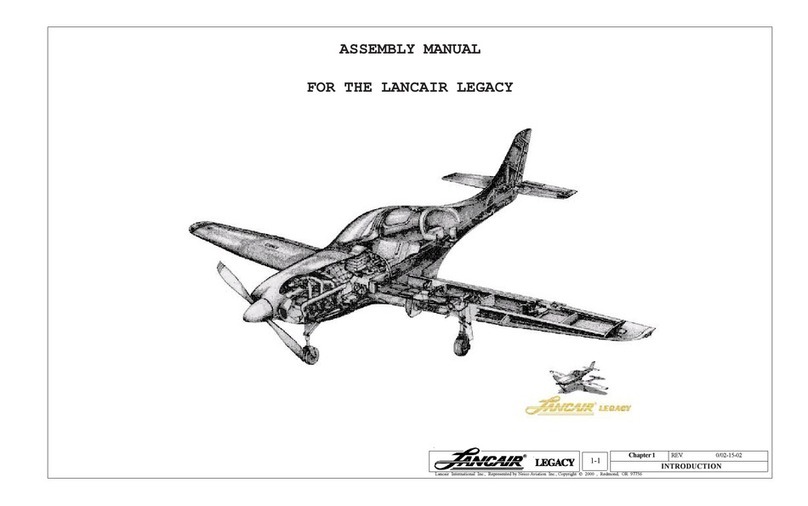Lancair International Inc., Represented by Neico Aviation Inc., Copyright 2008 Redmond, OR 97756
Chapter 1 Page 1.3 REV. 2nd Ed./08-15-06
Introduction to the Lancair ES FastBuild Kit
ES
1.3 The Manuals, Blueprints and the ES CD
Please read this manual! We encourage you to read this manual and then use it as your reference
tool as you build your airplane. In this age of computers that are user friendly, cars that provide a
warning light for every change in status, many people are out of the habit of reading manuals.
That philosophy will not work here. While there really aren't any complex steps to building this
aircraft, there are many that must not be overlooked. So, please do read this manual.
Each chapter should be read entirely and understood before beginning the work it describes. The
equipment and supplies called for in each chapter should be on hand and ready for use.
1.3.A Manual Layout
For ease of use and understanding, this assembly manual is laid out in a logical progression of
assembly steps. This manual is organized as follows:
Chapter 1 – Provides an overview of the shop requirements and necessary tools to build your
homebuilt airplane.
Chapter 2 – Describes safety considerations for building, general building procedures and how
to prepare and join parts.
Chapter 3 and all following chapters contain the actual assembly instructions. The chapters are
presented in the order your plane should be built. Assembly instructions are in a sequence that
either is a convenient construction order or is necessary due to the kit design.
Chapter Organization
Each assembly chapter is organized in the same sequence.
1. Introduction – Briefly describes the work that will be completed in this chapter, and special
construction requirements and if a pre-fit is necessary.
2. Parts List – Provides a complete list of the parts used in the construction procedures in the
chapter. Parts lists may not match a kit. A parts list can include all or part of a kit plus other
hardware from the H or K kit lists.
3. Construction procedures – this section is divided into specific areas of assembly. Each
division is defined by an alphabetic prefix: A, B, C, etc.
4. Graphics, including drawings and photographs – each graphic is numbered within an
alphabetic prefix: A.1, A.2, A.3, B.1, B.2, etc.
Symbols
The following symbols are used in the manual.
Revisions
Occasionally revisions to the manuals may be necessary. Updates are posted on the Lancair web
page. When updates are available, you need to immediately replace all outdated pages with the
revised pages. Discard the outdated pages.
The lower right corner of each manual page contains a revision date. The final edition of this
manual will have a zero followed by the date printed, for example, Rev. 0–06/12/2005. All
subsequent revisions will have the revision number followed by the date of that revision. All
revisions include a List of Revisions page for each chapter with updated pages When you receive
a List of Revisions page, you will need to inserted it in front of the first page of each revised
chapter.
Click on this symbol to view the photograph of the procedure that has just been
described.
Click on this symbol to view a series of photographs.
This symbol indicates a pre-fit is required.
This symbol indicates there is a detail view of the area covered by the magnifying
glass.




























